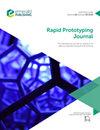纯锌及Zn10mg合金选择性激光熔炼工艺参数及力学性能的研究
IF 3.6
4区 工程技术
Q1 ENGINEERING, MECHANICAL
引用次数: 1
摘要
目的选择性激光熔化(SLM)技术作为一种典型的增材制造工艺,广泛应用于金属生物医学元件的制造。就生物降解性而言,锌及其合金代表了用于生物医学植入物的新一代金属材料。本文的目的是利用SLM技术获得具有高机械性能的Zn和Zn10Mg合金。研究了纯Zn和Zn10Mg合金样品的工艺参数与孔隙率的关系。设计/方法/方法使用SLM技术在惰性气体密闭室中制作样品。进行了初步实验,分析了激光功率和气体流量对蒸发、单轨形状和孔隙率的影响。为了评估各因素对相对密度的影响,采用了响应面法。结果该方法获得了令人满意的结果,其中组分的相对密度达到99.63%,抗压强度达到214 ± 在最佳工艺条件下为13MPa。独创性/价值锌按其低熔点和低沸点进行分类,这导致了成分的高孔隙率。使用SLM技术制备具有高相对密度的锌合金样品是困难的。本工作成功地获得了致密的Zn和Zn10Mg样品,并研究了它们的微观结构、力学性能和腐蚀行为。本文章由计算机程序翻译,如有差异,请以英文原文为准。
A study of selective laser melting process for pure zinc and Zn10mg alloy on process parameters and mechanical properties
Purpose
The selective laser melting (SLM) technique, as a typical additive manufacturing process, is widely used for the fabrication of metallic biomedical components. In terms of biodegradability, zinc and its alloys represent an emerging generation of metallic materials for biomedical implants. The purpose of this paper is to obtain the Zn and Zn10Mg alloys with high mechanical properties using the SLM technology. The relationship between the processing parameters and the porosity of pure Zn and Zn10Mg alloy samples was investigated.
Design/methodology/approach
The samples were fabricated using SLM technology working in an inert gas closed chamber. Preliminary experiments were conducted to analyze the laser power and gas flow on evaporation, single track form and porosity. To evaluate the influence of factors on relative density, the response surface methodology was applied.
Findings
The satisfactory results of the proposed method were achieved, in which the relative density of the components reached up to 99.63%, and compression strength reached 214 ± 13 MPa under optimal processing conditions.
Originality/value
Zinc is categorized by its low melting and boiling point, which leads to the high porosity of the components. It is difficult to prepare the Zn alloy samples with high relative density using SLM technology. This work successfully achieved dense Zn and Zn10Mg samples and investigated their microstructure, mechanical properties and corrosion behavior.
求助全文
通过发布文献求助,成功后即可免费获取论文全文。
去求助
来源期刊

Rapid Prototyping Journal
工程技术-材料科学:综合
CiteScore
8.30
自引率
10.30%
发文量
137
审稿时长
4.6 months
期刊介绍:
Rapid Prototyping Journal concentrates on development in a manufacturing environment but covers applications in other areas, such as medicine and construction. All papers published in this field are scattered over a wide range of international publications, none of which actually specializes in this particular discipline, this journal is a vital resource for anyone involved in additive manufacturing. It draws together important refereed papers on all aspects of AM from distinguished sources all over the world, to give a truly international perspective on this dynamic and exciting area.
-Benchmarking – certification and qualification in AM-
Mass customisation in AM-
Design for AM-
Materials aspects-
Reviews of processes/applications-
CAD and other software aspects-
Enhancement of existing processes-
Integration with design process-
Management implications-
New AM processes-
Novel applications of AM parts-
AM for tooling-
Medical applications-
Reverse engineering in relation to AM-
Additive & Subtractive hybrid manufacturing-
Industrialisation
 求助内容:
求助内容: 应助结果提醒方式:
应助结果提醒方式:


